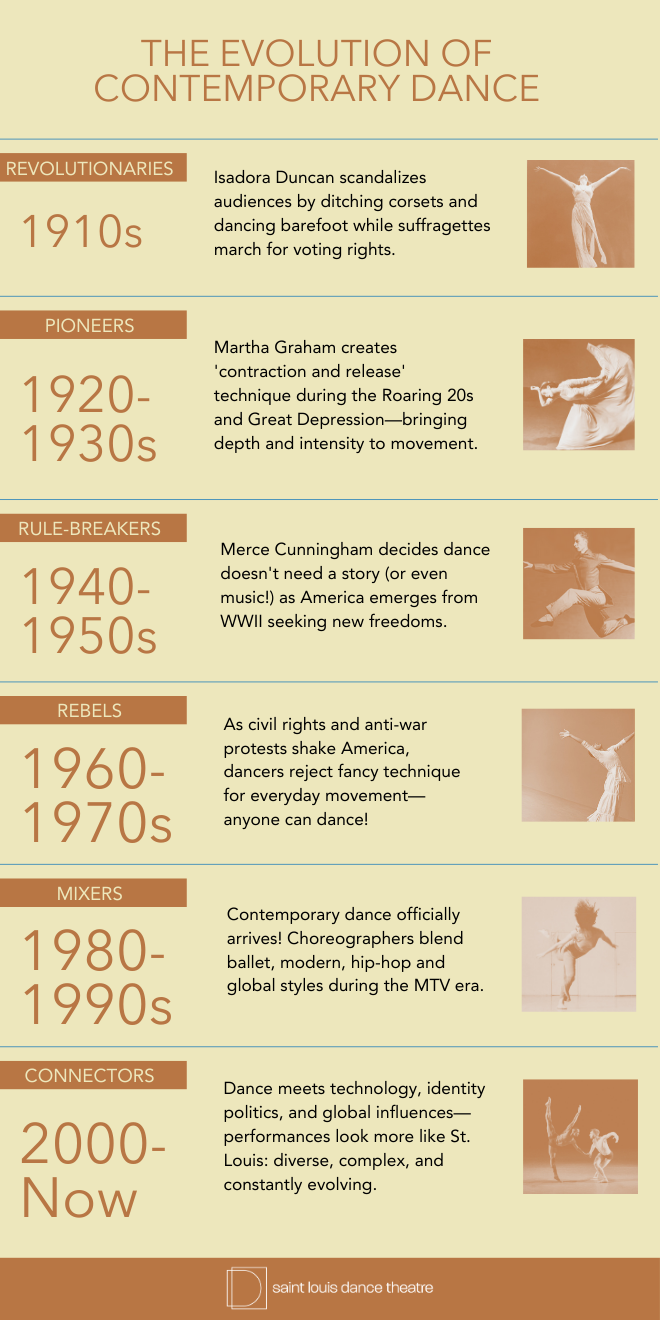A History of Contemporary Dance from a St. Louis Perspective
Art shapes cities just as powerfully as economics, politics, or geography. In St. Louis, a unique cultural identity has emerged from our history as both a gateway to western expansion and a hotbed of freedom movements—from the Dred Scott case to civil rights struggles. This mix of exploration and boundary pushing makes our city a natural hub for contemporary dance, which was born from the same kind of bold spirit and quest for self-expression.
What Makes Contemporary Dance Different?
If you've ever watched a dance performance and thought, "That doesn't look like ballet," you might have been seeing contemporary dance in action.
While classical ballet is about precision and tradition, modern dance emerged in the early 1900s as a rebellion against these constraints, and contemporary dance took this freedom even further.
The timeline below shows how this revolutionary art form evolved alongside powerful social and cultural movements:
How Did Contemporary Dance Evolve?
Modern dance pioneers like Isadora Duncan shocked audiences by dancing barefoot in flowing tunics instead of restrictive costumes. This rebellion against artistic conventions wasn't always welcomed—when Igor Stravinsky's ballet The Rite of Spring premiered in 1913 with Vaslav Nijinsky's revolutionary choreography, the audience was so shocked that they literally rioted in the theater.
But artists continued pushing boundaries. Martha Graham created powerful movements centered on breathing. Merce Cunningham broke with tradition by declaring dance could exist without storytelling or even music.
St. Louis has its own profound connection to dance culture through Katherine Dunham, often called the "queen of black dance." With a Ph.D. from the University of Chicago, Dunham revolutionized modern dance by incorporating African, Caribbean, and Haitian movements. In 1967, she established the Performing Arts Training Center in East St. Louis, where—following the 1968 riots after Martin Luther King Jr.'s assassination—she guided local youth to channel frustration into artistic expression. Until her death in 2006, her summer seminars in St. Louis attracted dancers worldwide, creating a legacy of using arts for social transformation that earned her the National Medal of the Arts, presented by President George H.W. Bush.
Contemporary dance emerges from these revolutionary roots but refuses to follow any single set of rules. It borrows from ballet, hip-hop, global dance traditions, and everyday movement, creating something entirely new—just as St. Louis has continually reinvented itself while honoring its past.
Did you know? Katherine Dunham's legacy lives on in St. Louis beyond her artistic influence. You can find her star on the St. Louis Walk of Fame on Delmar Boulevard, where she's honored alongside other notable St. Louisans who've made significant contributions to our cultural heritage.


